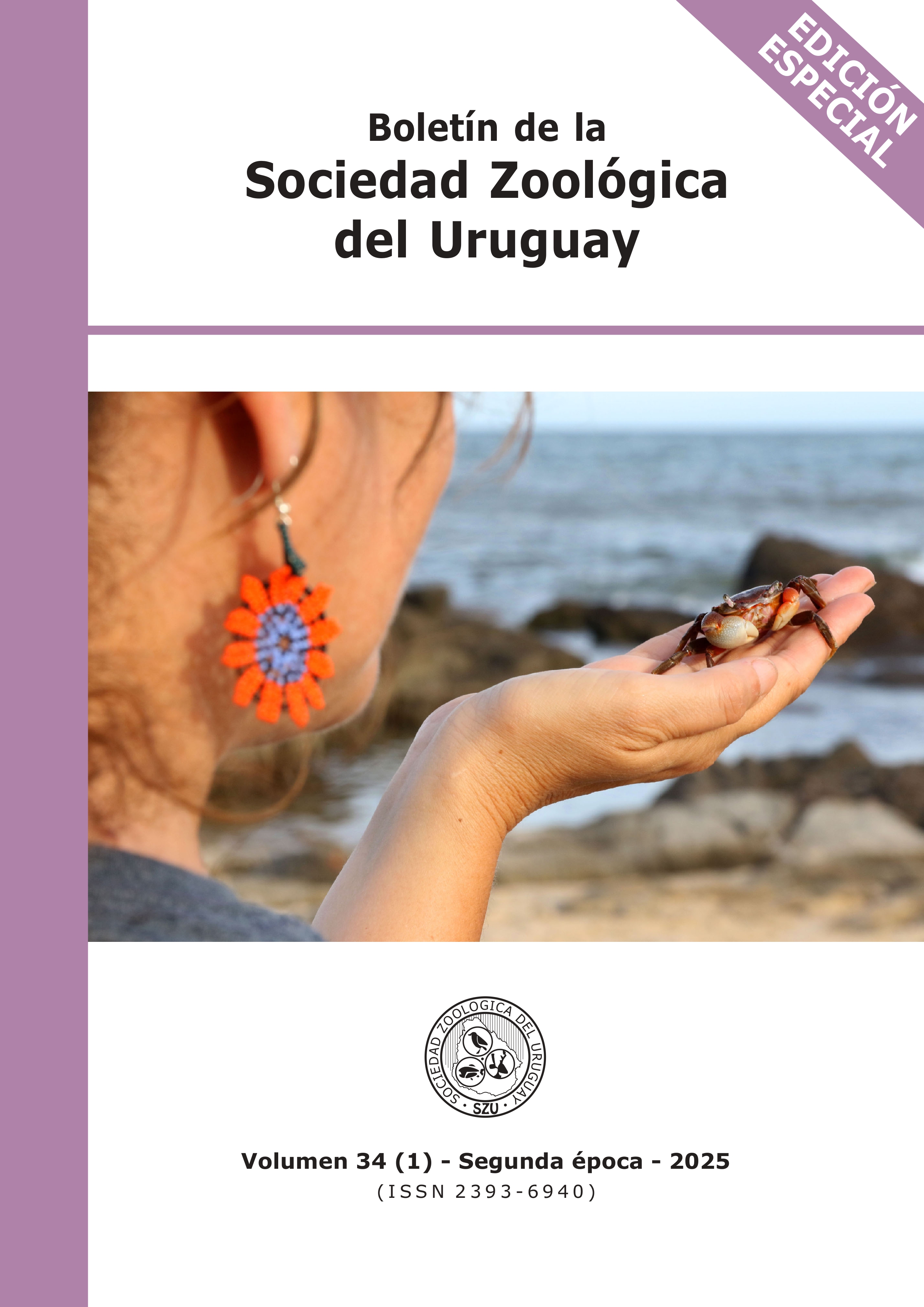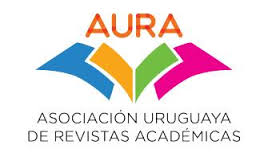EPIBIONTS ASSOCIATED TO MARINE LITTER IN BEACHES FROM URUGUAY, POSSIBLE INDICATORS OF ITS ORIGIN
DOI:
https://doi.org/10.26462/34.1.15Keywords:
marine litter, plastics, sandy beach, epibiontsAbstract
Marine anthropogenic litter has been recognized as a serious environmental, economic, human health, and aesthetic problem worldwide. Sandy beaches provide numerous ecosystem services in addition to recreation and are highly affected by marine litter. This study evaluated the composition of marine litter on three oceanic beaches from Uruguay, assessing buoyancy and the presence/ absence of epibionts growing on it. Floating plastics without epibionts were the most abundant type of litter in all the studied beaches. The absence of epibionts on litter allowed us to infer that sources of litter were mainly local. Additionally, a small proportion of floating plastics presenting epibionts (bivalve, bryozoans and barnacles) was registered, evidencing that those remained in the ocean time enough to be colonized before washing up on the beach, probably boosted by ocean currents. Our results suggest that most litter on these beaches has a local origin. This might be a consequence of poor management of waste generated by human activities in the region. Consequently, recommendations are to approach the problem from a local perspective including management and environmental education of communities.
Downloads
References
Cheshire, A.C., Adler, E., Barbière, J., Cohen, Y., Evans, S., … & Westphalen, G. (2009). UNEP/IOC Guidelines on Survey and Monitoring of Marine Litter. UNEP Regional Seas Reports and Studies, No. 186; IOC Technical Series No. 83: xii + 120 pp.
Chiba, S., Saito, H., Fletcher, R., Yogi, T., Kayo, M., Miyagi, S., Ogido, M., & Fujikura, K. (2018). Human footprint in the abyss: 30 year records of deep-sea plastic debris. Marine Policy, 96, 204-212.
De-la-Torre, G.E., Dioses-Salinas, D.C., Pérez-Baca, B.L., Cumpa, L.A.M., Pizarro-Ortega, C.I., Torres, F.G., ... & Santillán, L. (2021). Marine macroinvertebrates inhabiting plastic litter in Peru. Marine Pollution Bulletin, 167, 112296.
De-la-Torre, G.E., Romero Arribasplata, M.B., Lucas Roman, V.A., Póvoa, A.A., & Walker, T.R. (2023). Marine litter colonization: Methodological challenges and recommendations. Frontiers in Marine Science, 10, 1070575.
Galgani, F., Brien, A.S.O., Weis, J., Ioakeimidis, C., Schuyler, Q., Makarenko, I., ... & Bebianno, M.J. (2021). Are litter, plastic and microplastic quantities increasing in the ocean?. Microplastics and Nanoplastics, 1, 1-4.
Ghosh, S., Sinha, J.K., Ghosh, S., Vashisth, K., Han, S., & Bhaskar, R. (2023). Microplastics as an emerging threat to the global environment and human health. Sustainability, 15(14), 10821.
Gracia, A., Rangel-Buitrago, N., & Flórez, P. (2018). Beach litter and woody-debris colonizers on the Atlantico department Caribbean coastline, Colombia. Marine Pollution Bulletin, 128, 185-196.
Haram, L.E., Carlton, J.T., Centurioni, L., Choong, H., Cornwell, B., Crowley, M., ... & Ruiz, G.M. (2023). Extent and reproduction of coastal species on plastic debris in the North Pacific Subtropical Gyre. Nature Ecology & Evolution, 7(5), 687-697.
Harris, L.R., & Defeo, O. (2022). Sandy shore ecosystem services, ecological infrastructure, and bundles: New insights and perspectives, Ecosystem Services, 57, 101477.
Honorato-Zimmer, D., Kruse, K., Knickmeier, K., Weinmann, A., Hinojosa, I.A., & Thiel, M. (2019). Inter-hemispherical shoreline surveys of anthropogenic marine debris-a binational citizen science project with schoolchildren. Marine pollution bulletin, 138, 464-473.
Joppa, L.N., O'Connor, B., Visconti, P., Smith, C., Geldmann, J., Hoffmann, M., ... & Burgess, N.D. (2016). Filling in biodiversity threat gaps. Science, 352(6284), 416-418.
Kiessling, T., Gutow, L., & Thiel, M. (2015). Marine Litter as Habitat and Dispersal Vector. In Bergmann, M., Gutow, L., Klages, M. (eds) Marine Anthropogenic Litter. Springer, Cham. https://doi.org/10.1007/978-3-319-16510-3_6
Lebreton, L., van der Zwet, J., Damsteeg, J., Slat, B., Andrady, A., & Reisser, J. (2017). River plastic emissions to the world's oceans. Nature Communications 8, 15611.
Lenzi, J., Burgues, M.F., Carrizo, D., Machín, E., & Teixeira-de Mello, F. (2016). Plastic ingestion by a generalist seabird on the coast of Uruguay. Marine pollution bulletin, 107(1), 71-76.
Lozoya, J.P., De Mello, F.T., Carrizo, D., Weinstein, F., Olivera, Y., Cedrés, F., ... & Fossati, M. (2016). Plastics and microplastics on recreational beaches in Punta del Este (Uruguay): unseen critical residents?. Environmental Pollution, 218, 931-941.
Mantelatto, M.C., Póvoa, A.A., Skinner, L.F., de Araujo, F.V., & Creed, J.C. (2020). Marine litter and wood debris as habitat and vector for the range expansion of invasive corals (Tubastraea spp.). Marine Pollution Bulletin, 160, 111659.
Maxwell, S.L., Fuller, R.A., Brooks, T.M., & Watson, J.E.M. (2016). Biodiversity: the ravages of guns,
nets and bulldozers. Nature 536, 143-145.
Ocean Conservancy (2015). Stemming the tide: landbased strategies for a plastic-free ocean. Ocean
Conservancy and McKinsey Center for Business and Environment, 48pp.
ONU (2021). De la contaminación a la solución: Una evaluación global de la basura marina y la contaminación por plásticos. Naciones Unidas.
Owens, K.A., & Kamil, P.I. (2020). Adapting Coastal Collection Methods for River Assessment to Increase Data on Global Plastic Pollution: Examples From India and Indonesia. Frontiers in Environmental Science, 7, 208. doi:10.3389/fenvs.2019.00208
Pegado, T., Andrades, R., Noleto-Filho, E., Franceschini, S., Soares, M., Chelazzi, D., ... & Giarrizzo, T. (2024). Meso-and microplastic composition, distribution patterns and drivers: A snapshot of plastic pollution on Brazilian beaches. Science of The Total Environment, 907, 167769.
Poeta, G., Conti, L., Malavasi, M., Battisti, C., & Acosta, A.T.R. (2016). Beach litter occurrence in sandy littorals: The potential role of urban areas, rivers and beach users in central Italy. Estuarine, coastal and shelf science, 181, 231-237.
Rech, S. (2018). Los plásticos contaminantes marinos como vector de transporte para especies exóticas. Tesis de Doctorado en Ingeniería química, ambiental y bioalimentaria. Universidad de Oviedo, Oviedo. 143 pp.
Rech, S., Borrell, Y., & García-Vazquez, E. (2018). Anthropogenic marine litter composition in coastal areas may be a predictor of potentially invasive rafting fauna. PloS ONE. 13, e0191859. Doi: 10.1371/journal.pone.019185
Rodríguez, C., Fossatti, M., Carrizo, D., Sánchez-García, L., de Mello, F.T., Weinstein, F., & Lozoya, J.P. (2020). Mesoplastics and large microplastics along a use gradient on the Uruguay Atlantic coast: types, sources, fates, and chemical loads. Science of the Total Environment, 721, 137734.
Rumbold C.E., García G.O., & Seco Pon J.P. (2020). Fouling assemblage of marine debris collected in a temperate south-western Atlantic coastal lagoon: A first report. Marine Pollution Bulletin, 154, 111103.
Ryan, PG., Moore, C.J., van Franeker, J.A., & Moloney, C.L. (2009). Monitoring the abundance of plastic debris in the marine environment. Philosophical Transactions of the Royal Society B, 364, 1999-2012.
Scarabino, F., Sciandro, J., Vélez-Rubio, G., Burgues, F., Carrizo, D., Cedrés, F., ... & Lacerot, G.(2015). Management and research on plastic debris in Uruguayan Aquatic Systems: update and perspectives. Revista de Gestão Costeira Integrada-Journal of Integrated Coastal Zone Management, 15(3), 377-393.
Serra-Gonçalves, C., Lavers, J.L., & Bond, A.L. (2019). Global review of beach debris monitoring and future recommendations. Environmental science & technology, 53(21), 12158-12167.
Thiel, M., & Gutow, L. (2005). The ecology of rafting in the marine environment I. The floating substrata. Oceanography and Marine Biology Annual Review 42, 181-264.
UNEP (2016). Marine plastic debris and microplastics - Global lessons and research to inspire action and guide policy change. United Nations Environment Programme, Nairobi.
van Emmerik, T.H.M. (2024). The impact of floods on plastic pollution. Global Sustainability, 7, e17.
Velasco-Charpentier, C., Pizarro-Mora, F., Estrades, A., & Veléz-Rubio, G.M. (2016). Epibiontes en juveniles de tortugas carey Eretmochelys imbricata varadas en la costa del Departamento de Rocha, Uruguay. Revista de Biología Marina y Oceanografía, 51, 449-453.
Vélez-Rubio, G.M., Teryda, N., Asaroff, P.E., Estrades, A., Rodriguez, D., & Tomás, J. (2018). Differential impact of marine debris ingestión during ontogenetic dietary shift of green turtles in Uruguayan waters. Marine pollution bulletin, 127, 603-611.
Vidal, C., Lozoya, J.P., Tesitore, G., Goyenola, G., & Teixeira-de-Mello, F. (2021). Incidence of watershed land use on the consumption of meso and microplastics by fish communities in uruguayan lowland streams. Water, 13(11), 1575.
Wang, T., Li, B., Shi, H., Ding, Y., Chen, H., Yuan, F., ... & Zou, X. (2024). The processes and transport fluxes of land-based macroplastics and microplastics entering the ocean via rivers. Journal of Hazardous Materials, 133623.
Willis, K., Hardesty, D.B., Kriwoken, L., & Wilcox, C. (2017). Differentiating littering, urban runoff and marine transport as sources of marine debris in coastal and estuarine environments. Scientific reports, 7(1), 44479.











